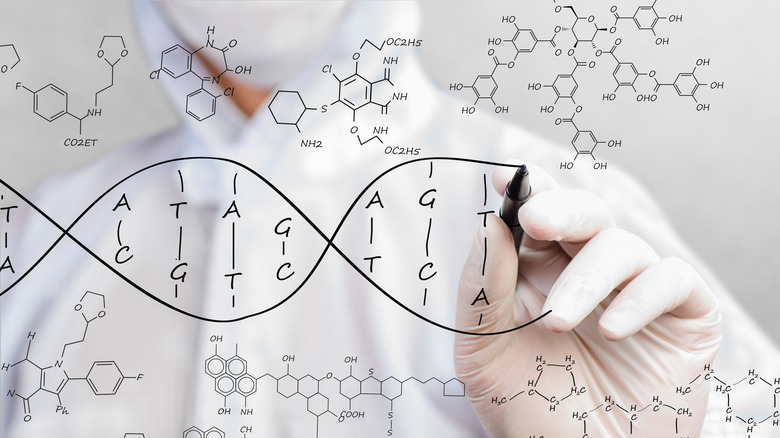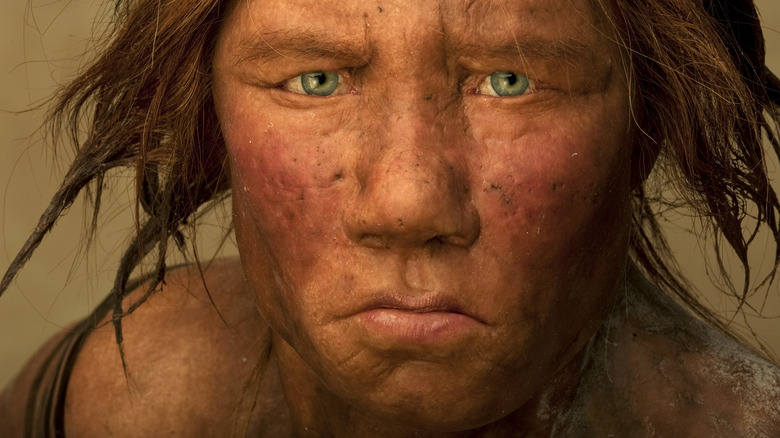How Long Does It Take For DNA To Break Apart?
From solving cold cases to tracing our own genealogy, DNA science has revolutionized our understanding of what makes us human. Thanks to decades of scientific research, we know a great deal about what DNA is and how it works — but even so, many more discoveries remain to be made about the fundamental building block of all living organisms. Among these relate to the longevity of DNA samples, and how much time it takes for any given DNA sample to break apart. Once scientists fully understand this, they might finally be able to figure out how far back we'll be able to date genetic material — and with it, how far deeply we'll be able to see into the nature of life itself with DNA alone.
Our understanding of DNA sequencing has significantly helped us take strides in scientific fields other than forensics and genealogy. Here's one example: Through DNA, scientists may one day be able to resurrect a wooly mammoth or other prehistoric animals through a process known as "de-extinction," in which scientists can potentially use the DNA of a close genetic relative to sequence and edit the DNA to match that of its extinct literal (and rhetorical) cousin, creating an embryo, and then delivering it via surrogacy (via Science). Indeed, studying DNA has also provided an unparalleled glimpse into the ancient world, helping us date ancient humans and other biological remains more accurately than ever before.
DNA is the blueprint for life
So how exactly does figuring out the shelf-life of DNA relate to answering long-held questions in science, like how humans evolved into what we are today? The answer is both simple and complicated: Because the base code embedded in the distinctive double-helix of a DNA strand is where life as we know it resides.
What would one day be known as DNA was first discovered in 1869 by a Swiss chemist named Friedrich Miescher, who spotted and later isolated a phosphorus-rich material while studying white blood cells he later identified as its cellular core, named his find the cell's "nuclein" — what we would later know by the name deoxyribonucleic acid, or DNA (via the National Human Genome Research Institute). However, it would be nearly a century before the importance of Miescher's discovery was fully realized, after scientists in the 1970s building off of his work began to understand that DNA samples could be linked to the living organisms they came from — and eventually, for the purposes of this article, given a biological age.
For researchers, the shelf-life of DNA has immediately practical purposes. Specifically, it helps scientists better understand how much of a timeframe they have for procuring accurate data from any DNA sample they want to test (via Nature). But it also means that if a DNA sample can last long enough — even as much as tens of thousands of years — it could also give us a window into the makeup of basic organisms from eons ago.
Can DNA last for millions of years?
No one knows for certain how long the viability of DNA can possibly last, but scientists have come close to an accurate estimate. According to findings published in 2012, a group of paleontologists studying dinosaur fossils observed that nucleotides — or, in layman's terms, the compound that binds DNA into the double-helix model found in every high school biology class — found within fossil DNA samples had a half-life of 521 years (via Nature). To put it simply, this meant that with every 521-year period, these nucleotides would be degraded by half of what remained, and that, per their calculations, could theoretically remain viable for up to 6.8 million years, but would only be useful for any sort of testing short of 1.5 million years.
But when it comes to the discussion of just how useful a DNA sample remains over time, there are many more factors than just how long it takes for DNA to break apart — the most important being the environment in which the DNA sample was found, as well as whether the sample has been contaminated by way of exposure to modern DNA. While this might mean even more slim pickings than hoped for, scientists have had some significant breakthroughs. As of this report, experts were able to use confirmed, useable DNA to date the skeletal remains of two Neanderthals found in Spain in 2012 to roughly 7,000 years ago, per Gizmodo, as well as observe major genetic differences compared to the Neanderthal DNA samples and human DNA today.


